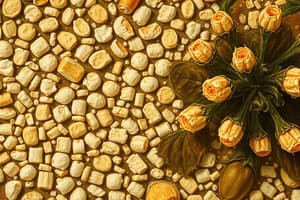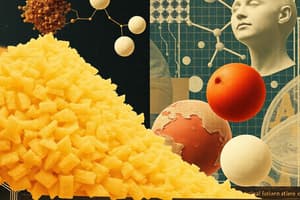Podcast
Questions and Answers
What is the primary form in which phosphorus is stored in the human body?
What is the primary form in which phosphorus is stored in the human body?
- As hydroxyapatite (correct)
- As nucleotides
- As phosphoric acid
- As proteins
Which statement best describes the function of phosphates in protein activity?
Which statement best describes the function of phosphates in protein activity?
- Phosphates enhance the stability of proteins.
- Phosphates bind irreversibly to proteins.
- Phosphates degrade proteins.
- Phosphates can switch proteins on or off by altering their shape. (correct)
What is the significance of the pKa value in relation to phosphoric acid?
What is the significance of the pKa value in relation to phosphoric acid?
- It indicates the concentration of water in the solution.
- It represents the point where acid and conjugate base concentrations are equal. (correct)
- It shows the strength of phosphoric acid compared to other acids.
- It is used to determine the solubility of phosphates.
Which bond is formed as a result of the reaction between two hydroxyl groups in phosphoric acid?
Which bond is formed as a result of the reaction between two hydroxyl groups in phosphoric acid?
Which factor does not contribute to the high free energy of ATP hydrolysis?
Which factor does not contribute to the high free energy of ATP hydrolysis?
What is the empirical formula for most carbohydrates?
What is the empirical formula for most carbohydrates?
Which type of carbon linkage is found in starch and glycogen?
Which type of carbon linkage is found in starch and glycogen?
In which case is the anomeric carbon located specifically at C1?
In which case is the anomeric carbon located specifically at C1?
What distinguishes D and L sugars?
What distinguishes D and L sugars?
Which of the following is a characteristic of epimers?
Which of the following is a characteristic of epimers?
Which of the following carbohydrates is a disaccharide?
Which of the following carbohydrates is a disaccharide?
What configuration do sugar rings typically adopt?
What configuration do sugar rings typically adopt?
What is the primary function of cellulose in plant cells?
What is the primary function of cellulose in plant cells?
How does penicillin affect bacterial cells?
How does penicillin affect bacterial cells?
Which type of linkage is found in alpha-glucans?
Which type of linkage is found in alpha-glucans?
What is the primary role of glycosyltransferase enzymes?
What is the primary role of glycosyltransferase enzymes?
What structure do glycoproteins typically contain?
What structure do glycoproteins typically contain?
Which of the following correctly describes the structure of peptidoglycan?
Which of the following correctly describes the structure of peptidoglycan?
What component primarily determines the function of proteoglycans?
What component primarily determines the function of proteoglycans?
Which blood group produces no functional glycosyltransferases?
Which blood group produces no functional glycosyltransferases?
In the context of SARS-CoV-2, what is the role of glycans on the spike protein?
In the context of SARS-CoV-2, what is the role of glycans on the spike protein?
What accounts for the compact and easily accessible structure of alpha-glucans?
What accounts for the compact and easily accessible structure of alpha-glucans?
Flashcards
What is a carbohydrate's primary role?
What is a carbohydrate's primary role?
A type of carbohydrate that serves as a major energy source for living organisms.
What is a disaccharide?
What is a disaccharide?
Two monosaccharides linked together by a glycosidic bond.
What is an O-glycosidic bond?
What is an O-glycosidic bond?
A covalent linkage between anomeric carbon of a monosaccharide and the oxygen atom of an alcohol molecule.
What is a polysaccharide?
What is a polysaccharide?
Signup and view all the flashcards
What is glycogen?
What is glycogen?
Signup and view all the flashcards
What is starch?
What is starch?
Signup and view all the flashcards
What is a non-reducing end?
What is a non-reducing end?
Signup and view all the flashcards
Phosphate
Phosphate
Signup and view all the flashcards
pKa
pKa
Signup and view all the flashcards
Phosphodiester bond
Phosphodiester bond
Signup and view all the flashcards
ATP
ATP
Signup and view all the flashcards
ATP hydrolysis
ATP hydrolysis
Signup and view all the flashcards
Alpha-glucans
Alpha-glucans
Signup and view all the flashcards
Reducing Sugars
Reducing Sugars
Signup and view all the flashcards
Cellulose
Cellulose
Signup and view all the flashcards
Peptidoglycan
Peptidoglycan
Signup and view all the flashcards
Glycoconjugate
Glycoconjugate
Signup and view all the flashcards
Glycolipid
Glycolipid
Signup and view all the flashcards
Glycoprotein
Glycoprotein
Signup and view all the flashcards
Proteoglycans
Proteoglycans
Signup and view all the flashcards
Glycosyltransferases
Glycosyltransferases
Signup and view all the flashcards
Blood Groups
Blood Groups
Signup and view all the flashcards
Study Notes
Carbohydrates
- Found in all living organisms
- Key roles include energy storage, transport, cell communication, structural components (plants, animals, bacteria, fungi), and DNA/RNA components.
- Composed of carbon, hydrogen, and oxygen; some also contain sulfur and nitrogen.
- Formula for most carbohydrates: (CH₂O)ₙ
- Consist of two or more hydroxyl groups and either an aldehyde or ketone group.
- Known as sugars, saccharides, or glycans.
- Simplest carbohydrates are glyceraldehyde and dihydroxyacetone (3 carbons).
Chirally Active Sugars
- Most sugars are optically active, meaning they can rotate plane-polarized light.
- Glyceraldehyde exhibits stereoisomerism.
Carbohydrate Classifications
- Based on the number of carbon atoms:
- Triose (3 carbons)
- Tetraose (4 carbons)
- Pentose (5 carbons)
- Hexose (6 carbons)
- Examples of hexoses include glucose, mannose, and galactose.
- Examples of pentoses include ribose, xylose, and arabinose.
Carbohydrate Rings
- Sugars with four or more carbons typically form ring structures.
- Most common for 5- or 6-carbon sugars.
Aldoses and Ketoses
- Aldoses contain an aldehyde group.
- Examples include glucose (6 carbons), glyceraldehyde (3 carbons), and ribose (5 carbons).
- Ketoses contain a ketone group.
- Examples include fructose (6 carbons) and ribulose (5 carbons).
Sugar Ring Conformations
- Rings exist in non-planar configurations (e.g., chair conformations).
- Axial positions are oriented up/down, perpendicular to the ring.
- Equatorial positions are in the same plane as the ring.
- Axial positions experience more steric hindrance.
Anomers
- Isomeric forms of cyclic sugars.
- Distinguished by the orientation of the hydroxyl group (-OH) on the anomeric carbon (C1 in aldoses, C2 in ketoses).
- Alpha- anomer: -OH group is axial.
- Beta- anomer: -OH group is equatorial.
D and L Sugars
- Most common sugars have 5-6 carbons and multiple asymmetric carbons (e.g., glucose has 4).
- Two stereoisomers of glucose.
- D and L forms are enantiomers (mirror images).
- Nearly all naturally occurring sugars are in the D-configuration.
Epimers
- Diastereoisomers (not mirror images) that differ at only one chiral carbon.
- D-glucose and D-galactose are epimers at carbon 4.
- D-glucose and D-mannose are epimers at carbon 2.
Carbohydrate Polymers
- Monosaccharides link to form more complex carbohydrates.
- Disaccharides (two monosaccharides), Oligosaccharides (2-10 monosaccharides), and Polysaccharides (more than 10 monosaccharides).
- Glycosidic bonds hold the sugars together.
Glycosidic Bonds
- Covalent linkages formed between anomeric carbon of one monosaccharide and the oxygen atom of another alcohol molecule (O-glycosidic bond) or a nitrogen atom of an amine (N-glycosidic bond).
- Glycosidic bonds can form modified carbohydrates
- Can be alpha or beta.
Roles of Carbohydrates in Biology
- Major source of energy for metabolism.
- Important for energy storage (starch and glycogen).
- Structural components (cellulose, peptidoglycan).
- Involved in signaling (cell-cell communication, host-pathogen recognition).
Disaccharides
- Two monosaccharides joined by a glycosidic bond.
- Examples include maltose (two α-glucose), lactose (glucose and galactose), and sucrose (glucose and fructose).
Polysaccharides
- Energy storage polysaccharides like starch (plants) and glycogen (animals).
- Both primarily consist of glucose units linked by α-glycosidic bonds (branched and straight chains)
Starch and Glycogen
- Straight chains via α(1→4) linkages to form a helix
- Branched chains via α(1→6) linkages allowing for rapid enzyme access and quick release of glucose.
Cellulose
- Unbranched β-glucose polymer.
- Structural component of plant cell walls.
- β(1→4) linkages give rise to long, strong strainght chains that are difficult to digest.
Peptidoglycan
- Structural component of bacterial cell walls; consists of alternating NAG and NAM units linked by glycosidic bonds.
- Cross-linking peptides provide strength and rigidity; susceptible to penicillin.
Glycoconjugates
- Carbohydrates covalently attached to proteins or lipids.
- Examples include glycolipids and glycoproteins.
Glycolipids
- Lipid + carbohydrate.
- Found in cell membranes; involved in cell recognition (e.g., blood groups).
Glycoproteins
- Protein + carbohydrate.
- Important for cell recognition and adhesion, protein folding and stability;
- Types:
- N-linked: attached to asparagine side chains (often on secreted proteins).
- O-linked: attached to serine or threonine side chains (often intracellular).
Proteoglycans
- Protein core with attached glycosaminoglycans (GAGs).
- Important components of the extracellular matrix.
- Provide lubrication and structural support.
- Bind water and form hydrated gels
- Important for cell adhesion.
Blood Groups
- Determined by specific glycosyltransferases that add sugars to core oligosaccharides.
Glycans (Complex Carbohydrates)
- Play a critical role in host-pathogen interactions.
- SARS-CoV-2's spike protein is heavily glycosylated, aiding its ability to bind to ACE2 receptors.
Phosphorus in Biology
- Essential component of many biological molecules.
- Found in bones (as hydroxyapatite).
- Constituent of cell membranes, energy molecules (ATP), and nucleic acids (DNA and RNA).
Phosphate Groups
- Phosphate (PO4⁻³) is tetrahedral
- Phosphate's importance for stability arising from electrons delocalising around phosphate.
- Importance in control of protein activity by adding/removing phosphate groups
- Important in high-energy molecules and nucleotides
Phosphodiester Bonds
- Found in nucleic acids; form the backbone.
- Formed through reaction of hydroxyl groups and phosphoric acid.
ATP and Hydrolysis
- Energy currency in cells;
- High-energy phosphate bonds (phosphoanhydride bonds), releasing energy through hydrolysis.
- Hydrolysis driven by electrostatic repulsion, resonance stabilization, and solvation of products.
Studying That Suits You
Use AI to generate personalized quizzes and flashcards to suit your learning preferences.




